If you wanted a glimpse of “playoff-style hockey,” you got it.
The Calgary Flames probably aren’t going to make the playoffs, but they played that style of game tonight. They did an excellent job of clogging up the neutral zone, making life difficult for Toronto’s forwards as they tried to carry the puck up the ice with possession.
The Leafs ended up losing the game 3-2 in overtime after a blown coverage from Auston Matthews and Morgan Rielly resulted in Johnny Gaudreau finding alone in front. From there, his hands did the rest of the work.
This was a boring game to watch if you want high-tempo offense. If you’re interested in gauging Toronto’s play against tighter-checking teams, though, it gave us a sneak peek of how things might play out at 5v5, particularly in the neutral zone.
Without further ago, let’s dive deeper into this game as we go through each player individually. It’s time for some report cards!
5 Stars
Game Puck: John Tavares (C, #91) — Earlier in the season, I was concerned that Tavares wasn’t breaking down defenders very often in 1-on-1 situations.
I no longer have that concern.
This looks like the JT of old, pumping the breaks in the offensive zone and stick-handling his way around his man. In the clip above, he draws two defenders towards him, opening up space for his teammates to get open.
The end result there was obviously nice, but it’s the process of how that chance gets created that matters most to me. Tavares was singlehandedly driving offense tonight, getting around his man on the cycle, which put the Flames’ defense into panic mode.
It’s good to know that Tavares picked up two assists for his troubles.
4 Stars
Alex Kerfoot (C, #15) — You could make the case that Kerfoot played his way into staying on the Leafs‘ roster over the last week or so. I’m never a huge fan of overreacting to small sample sizes, and I doubt Kyle Dubas is either, but Kerfoot has been much more noticeable as a puck-hound when he’s pressuring opponents lately, which has helped him force more turnovers.
It’s also how he created a goal for… Alex Kerfoot.
After forcing the puck loose, Kerfoot finds himself in some open ice and actually shoots it for once. Good for him! Considering his efforts on the defensive side of the puck, it’s nice to see him get rewarded offensively.
Mitch Marner (RW, #16) — Here’s a constant problem I face when I’m evaluating these players. Let’s say someone has an awesome night at 5-on-5, leads their team in scoring chances, but makes one dumb decision in 3-on-3.
How do we reconcile that?
Frankly, I’ve never worried too much about 3-on-3 play considering playoff hockey is mostly played at 5-on-5, but we can still admit that shooting the puck from the blueline wasn’t exactly the best move from Marner in overtime.
For the rest of the game, he was Toronto’s most electric forward in transition, which isn’t saying much. Even Marner struggled to slice through Calgary’s defense tonight, but he was successful on a few occasions, especially off of turnovers. He was at his best when Auston Matthews was nearby to run a quick give-and-go passing sequence at the blueline.
Marner probably should’ve picked up a goal and/or an assist tonight, but sometimes the Puck Luck Gods aren’t with you.
The Rielly-Brodie Pairing — Remember what I just said about 3-on-3 overtime?
I completely understand why this is still a tough look for fans to forget.
This is yet another 2-on-2 rush that Morgan Rielly treats as a 2-on-1, failing to communicate with his teammate as to who picks up who. He also basically takes himself out of the play while failing to take away the pass. Matthews obviously deserves some blame there, too, which we’ll discuss in more detail when we get to his section.
Now, if we take a step back and look at how the Rielly-Brodie pairing performed at 5-on-5, they had the best shot and scoring chance differential on the team by a significant margin. They were living in the offensive zone despite all that tight-checking we’ve brought up. Heck, Toronto scored two more goals than Calgary when Rielly and TJ Brodie were on the ice.
As mad as you are at Rielly right now, I’d argue he played well in this game.
David Rittich (G, #33) — 10 seconds into the game, Rittich came flying out of his crease to play the puck. I think it’s safe to say he fired up to play his first game against his former team. The rest of his night went about as well as you could’ve hoped up until the Gaudreau breakaway.
Rittich was steady all evening, controlling his rebounds well and settling down any moments of chaos in the Leafs‘ end. He came up with a few big saves on Elias Lindholm late in the third period, which helped Toronto secure the one point.
3 Stars
Zach Hyman (RW, #11) — Every time I do these evaluations of Hyman in 2021, I’m reminded of the 2016 version of me who couldn’t stand this guy playing in Toronto’s top six. “He can’t finish; he isn’t skilled enough to play with elite talent.”
Sometimes in life, you have to admit you were wrong. I was wrong about Zach Hyman.
Hard to think of a player I've been as wrong about as I was about Hyman. I wasn't sure he was going to stick in the NHL for very long after that first season. He's improved substantially.
— draglikepull (@draglikepull) April 13, 2021
It’s crazy how far he’s come as a puck carrier. When his team is on the cycle, Hyman is actually able to wheel around the OZ now and look for passes that weren’t available to him five years ago. It’s made him a much more effective player in the offensive zone.
Tonight’s game puts him on pace for 30 goals over an 82 game season. Who would’ve thunk?
Alex Galchenyuk (LW, #12) — While we’re talking about making plays on the cycle, it’s an aspect of Galchenyuk’s game that separates him from some of the other players Toronto has tried in their top six this season. He can make the “next play” when his teammates are roaming around the offensive zone.
It usually isn’t the game-breaking play, but some form of a deke or creative pass that allows the team to maintain possession and continue creating offense, instead of the play dying on his stick (i.e. Wayne Simmonds).
As a side-note: I didn’t love Galchenyuk on the half-wall of PP2. Then again, if the Leafs end up top-loading PP1, I can see why the team might be forced to play him there. Other than Jason Spezza, there aren’t too many high-skill options to run the power play from the wall.
Ilya Mikheyev (LW, #65) — Another game, another Ilya Mikheyev shot on the penalty kill with an xG of zero percent. I’m sorry, I genuinely feel bad for the Soupman’s lack of shorthanded goals this season. He leads the league in 4v5 chances, so you’d have to think one of them will go in eventually.
At even strength, I really enjoyed Mikheyev on the “wide cycle” in the offensive zone, using his skating to create separation from his man on the perimeter. He wasn’t able to get to the middle, but puck possession is shot suppression.
Mikheyev is there to prevent goals. With his ability to play keep-away, it acts as a form of defense, just maybe not the way you picture it in your head.
The Muzzin-Holl Pair — Sticking with our last point, defense is the absence of anything. It’s preventing your opponent from generating offense. That makes it something that’s very difficult to see with the naked eye, even for those of us sickos who spend endless hours studying the game.
In the year 2021, stopping your opponent from creating transition opportunities is the name of the game. When Justin Holl closes his gap and separates an opposing forward from the puck, that’s defense. When he pinches at the right time to keep a play alive, that’s also defense.
When Jake Muzzin turns the puck over on zone entries, that’s offense for the other team. I actually thought he played a strong defensive game on Tuesday night, but the man is not a great puck-carrier. Considering how much he struggled with gaining the zone on PP2, I wonder when might be a good time to bring Rasmus Sandin into the fold.
2 Stars
Joe Thornton (LW, #97) — Let’s start with his play tonight. It wasn’t great, although Thornton was able to complete a few of those east-west passes to spread the ice horizontally. It’s worth noting he played a strong shift with Matthews-Marner in the third period, starting a passing sequence at the blue line that resulted in a quality chance.
But here’s the main topic we need to address: Spezza is willing to rest on back-to-backs and Thornton clearly isn’t. You could argue that it’s someone else’s job to convince Thornton to rest, whether it’s Sheldon Keefe or Kyle Dubas, but at the end of the day, someone needs to arrive at that conclusion.
If you’re going to maximize the Leafs‘ chances of winning a Stanley Cup, it doesn’t make any sense to burn out your 41-year-old veteran in meaningless regular-season games. And yes, I say that as someone who writes about these games for a living.
Pierre Engvall (C, #47) — Defensively, I liked Engvall’s play. He looked much more physical in DZ coverage right from the get-go, which is something Keefe clearly wants to see more from him. Engvall was also disruptive on the backcheck, taking away rush opportunities with his speed and length.
I’m so used to comparing Engvall to Mikheyev, so I’d like to bring up play with the puck. Mikheyev actually made a few skills plays tonight in the OZ, whereas Engvall wasn’t very noticeable in that department. He has similar speed and reach to Mikheyev, so there’s no reason he shouldn’t be making similar plays on the cycle.
The Dermott-Bogosian Pair — Earlier in the game, Travis Dermott let Gaudreau get behind him for a breakaway. Later on, Dermott hopped over the boards late on what ended up being a 2-on-1. Those are some of the little things he needs to watch out for. I love his aggressive gap in the neutral zone, but it’s not worth it if you get burned with consistency.
Overall, this was a rough night for the third pair. Bogosian was getting beat to loose pucks, Dermott was failing (again) to get his point shots through traffic, and at the end of the day, they got caved in at 5v5. Players with their cushy usage shouldn’t be getting filled in.
Scott Sabourin (RW, #49) — I remember when Ben Harpur played a preseason game and I tried to evaluate him as I would any other hockey player. “He’s not an NHL player” was the conclusion I quickly arrived at based on his lack of mobility.
With Sabourin, I can tell you with pretty good confidence that he’s not an NHL player, but I doubt anyone will care when they see him punch Milan Lucic in the face.
This is cool and everything, but Sabourin can’t play hockey. I’m not a huge fan of playing a guy 4.5 minutes so he can drop the gloves off the draw and deliver one big hit on a play that still resulted in a clean breakout. Call me a nerd, but I prefer it when these guys can actually make a play with the puck on their stick (i.e. Kyle Clifford).
1 Star
Auston Matthews (C, #34) — His defensive awareness in 3-on-3 this season hasn’t exactly been pristine. What’s more concerning is that there was a play at 5-on-5 where Matthews blew his F3 assignment, jumping into the play as the fourth Leafs player below the dots.
This should’ve resulted in a 2-on-1. It’s not like Matthews to blow assignments like this. In the game of hockey, you need to take risks to score goals — especially when you’re on pace for over 60 of them across 82 games — but he needs to be smarter there.
What’s separated him from other elite goal scorers is that Matthews also has the ability impact the game defensively. He was very poor in that department tonight, which is rare for him this season.
Wayne Simmonds (RW, #24) — I want Wayne Simmonds to succeed. We all do. When pucks keep dying on his stick in all three zones, though, I think it’s time to admit that he isn’t accomplishing much at 5v5.
Wayne Simmonds reminds me of David Clarkson recently.
— Platinum Seat Ghosts (@3rdPeriodSuits) April 14, 2021
This is why you pay one year of term for intangibles instead of seven.
Nick Robertson (LW, #89) — I remain high on Nick Robertson as a prospect, but assessing him as an NHL player tonight, he wasn’t able to make many plays up the ice. In his defense, not many of his teammates could, either, but Robertson’s skillset is one that you would hope could help you gain clean entries.
He’s also shooting from terrible locations far too often, which is part of the growing curve for younger players. It’s good that he’s confident in his shot, but you’re not beating NHL goalies from outside the dots.
Coaching Staff — Here’s a quick grocery list of concerns at the moment:
- Toronto’s power play is 1 for its last 37
- Jason Spezza is resting and Joe Thornton isn’t
- A non-NHLer just played an NHL game for the Leafs
- Taylor Hall got traded for a 2nd round pick
Sorry, that last one is more a gripe about player evaluation.
Heat Map
Here’s a quick look at where each team’s shots were coming from at even strength, courtesy of Natural Stat Trick.
Despite only generating 43 percent of the shots at 5v5, the Leafs controlled 52 percent of the scoring chances. That’s not a differential you can sustain over a large sample, but if we’re just evaluating a single game, it’s nice to know Toronto can still impact shot quality to a high degree.
Keep in mind the Leafs rank 11th in the NHL in shot share at 5v5 this season, but 3rd in scoring chance share and expected goals.
Game Score
Game score is a metric developed by The Athletic’s Dom Luszczyszyn to measure single-game performance. You can read more about it here.
Tweets of the Night
Kerfoot: "Our dumps weren't great."
— James Mirtle (@mirtle) April 14, 2021
Mine either, man.
A lot of people have been asking which of Simmonds or Thornton sit out when the full roster is healthy and the correct answer is 'both'.
— J (@Account4hockey) April 14, 2021
Why would you say something so brave, yet so true?
Final Thought
This was the second game in a row where things were really tight in the neutral zone. Much like the Columbus series last year, Toronto struggled to slice through the trap in transition.
On nights like these, they really could’ve used William Nylander to transport the puck through traffic, or dare I say, Taylor Hall.





















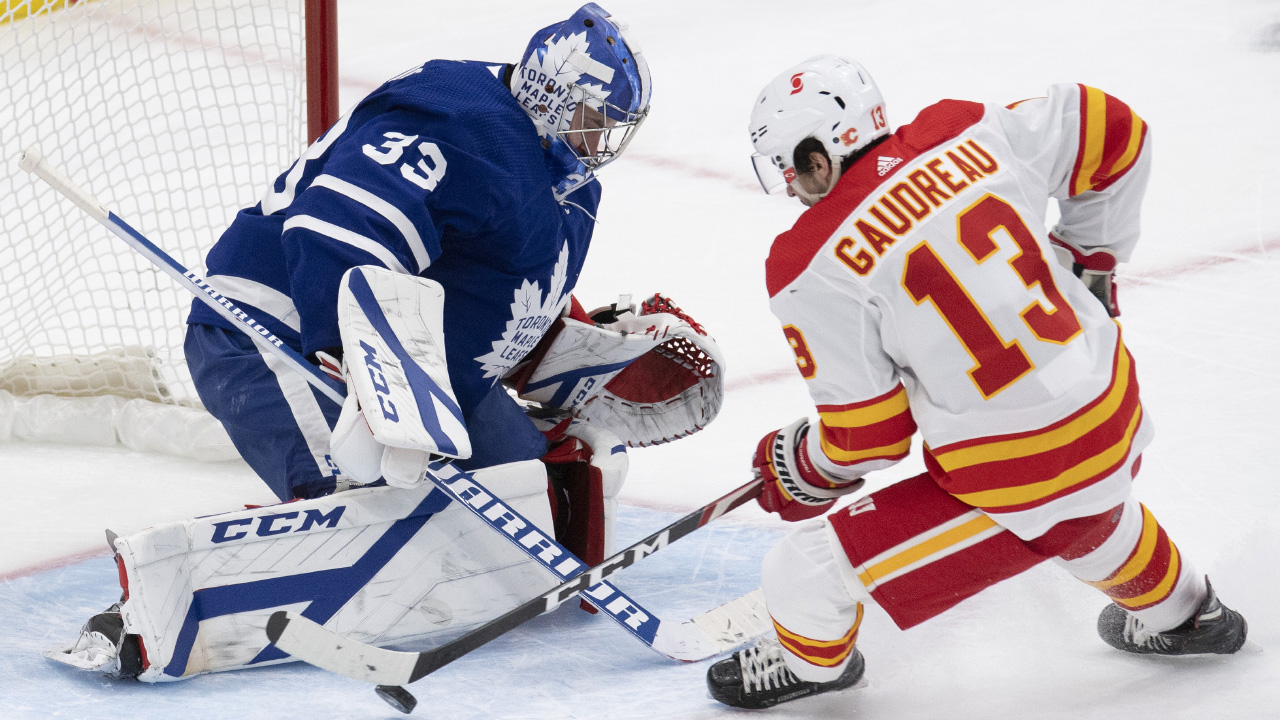
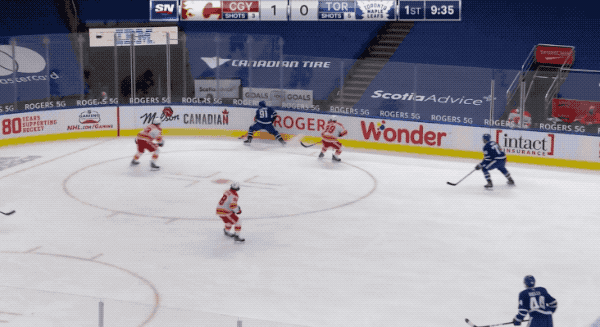
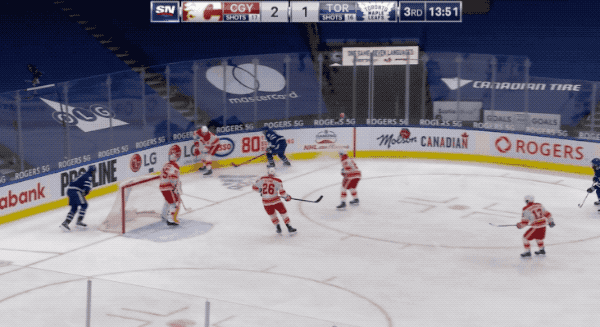
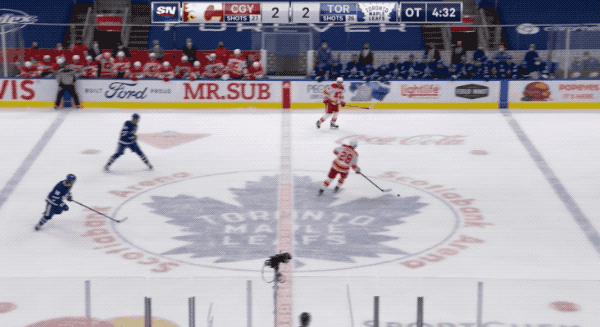
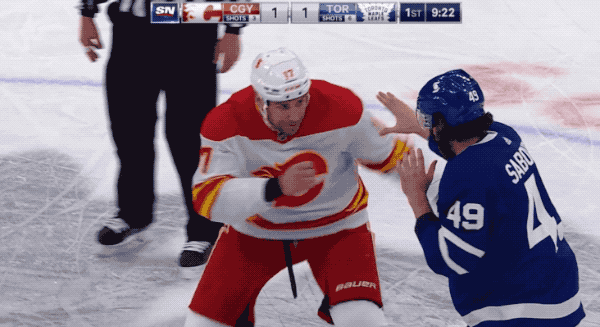
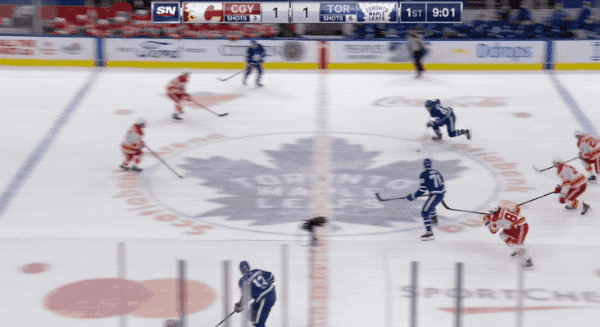
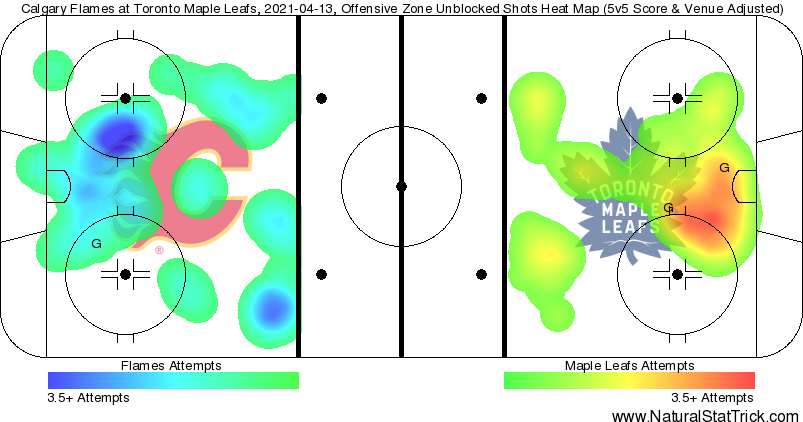












![New Leaf Anthony Stolarz on the opportunity in Toronto: “In Florida, I knew my role as a backup… Now, [Joseph Woll] and I are competing for starts… As a goalie, that’s all you can ask for” Anthony Stolarz, Stanley Cup win, now Maple Leaf](https://mapleleafshotstove.com/wp-content/uploads/2024/07/anthony-stolarz-sc-100x70.jpg)
